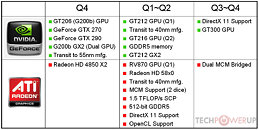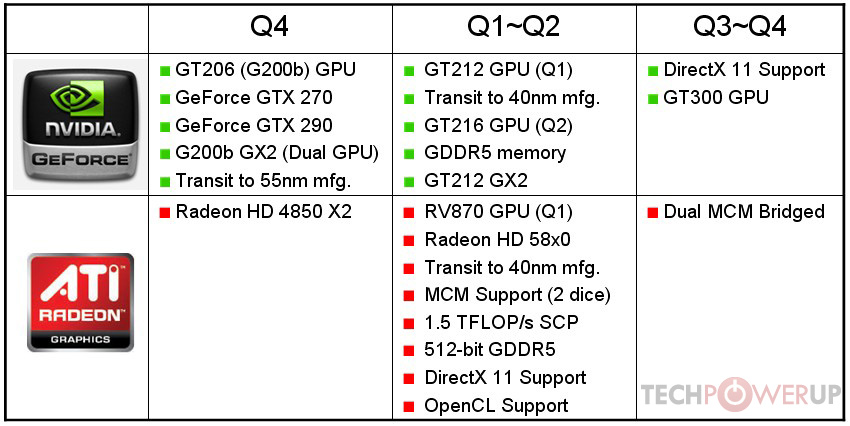- Joined
- Oct 9, 2007
- Messages
- 47,670 (7.43/day)
- Location
- Dublin, Ireland
| System Name | RBMK-1000 |
|---|---|
| Processor | AMD Ryzen 7 5700G |
| Motherboard | Gigabyte B550 AORUS Elite V2 |
| Cooling | DeepCool Gammax L240 V2 |
| Memory | 2x 16GB DDR4-3200 |
| Video Card(s) | Galax RTX 4070 Ti EX |
| Storage | Samsung 990 1TB |
| Display(s) | BenQ 1440p 60 Hz 27-inch |
| Case | Corsair Carbide 100R |
| Audio Device(s) | ASUS SupremeFX S1220A |
| Power Supply | Cooler Master MWE Gold 650W |
| Mouse | ASUS ROG Strix Impact |
| Keyboard | Gamdias Hermes E2 |
| Software | Windows 11 Pro |
The year 2008 so far, has been very eventful for the graphics card market. A reinvigorated GPU lineup by ATI, brought in some fierce competition to NVIDIA, which resulted in a tug-of-war with pricing graphics cards in the market, with either company refusing to lose on grounds of pricing. This event, coupled with the announcement of several game titles by game publishers, resulted in bumper-sales of graphics cards, giving the present state of the global economy little or no relevance.
The months to come hold the same amount of importance for both AMD and NVIDIA, where the next round of competition begins with successors to current high-end products being slated. NVIDIA is expected to continue with its monolithic high transistor-count GPU design methodology, while AMD could bring in a little change to the way it uses two efficient GPUs to build powerful products.

The change AMD is planning on is using a Multi-Chip Module (MCM), a design similar to the one on Intel microprocessors, where Intel has been making some of its quad-core processors using two dual-core dice on an MCM. The module facilitates faster interconnection between the GPU cores, than if the cores were to communicate over a PCI-Express bridge chip, or using internal CrossFire ports. This would result in a single GPU with two dice, in essence, a dual-core GPU. The RV870 would be the first to support an MCM design, with unit cores featuring 25% more stream-processors than its predecessor, while upping the rated shader compute power to 1.5 TFLOP/s. In effect, it could feature a 512-bit GDDR5 memory bus, support DirectX 11, and OpenCL (Compute language, a GPGPU API). According to this projection, AMD could be out with a DirectX 11 GPU at least six months ahead of NVIDIA, although it remains to be seen if there are any games that come out that soon to take advantage of the technology. Between Q3 and Q4 2009, AMD could plan on a dual-MCM setup, bringing together two such cores with two unit cores each.
On to the green camp, and NVIDIA seems to have concrete plans to respond to AMD, with the GeForce GTX 270, and GeForce GTX 290 planned for this quarter. The two new SKUs are based on a 55nm silicon fabricated G200, the G200b, also known as GT206. Within this quarter itself, NVIDIA plans to prepare a dual-GPU card based on G200b cores, to lead its front. In Q1 2009, the company is planning its transit to the 40nm silicon process, with GT212. There's little known about this chip, while GT216 in Q2 shows NVIDIA incorporating GDDR5 memory across a wide memory bus. This will also be the time when NVIDIA plans a dual-GPU card out of these chips. Finally in Q4, comes GT300, the next generation GPU from NVIDIA that brings in support for DirectX 11.
Year 2009 along with the rest of 2008, promise to be times when both graphics giants take computational power to the next level. It remains to be seen, if NVIDIA is able to deliver the punch, in order to rebuild whatever ground it lost to AMD, or if AMD goes for the kill with its innovation. Either way, these are good times for the buyers.
View at TechPowerUp Main Site
The months to come hold the same amount of importance for both AMD and NVIDIA, where the next round of competition begins with successors to current high-end products being slated. NVIDIA is expected to continue with its monolithic high transistor-count GPU design methodology, while AMD could bring in a little change to the way it uses two efficient GPUs to build powerful products.

The change AMD is planning on is using a Multi-Chip Module (MCM), a design similar to the one on Intel microprocessors, where Intel has been making some of its quad-core processors using two dual-core dice on an MCM. The module facilitates faster interconnection between the GPU cores, than if the cores were to communicate over a PCI-Express bridge chip, or using internal CrossFire ports. This would result in a single GPU with two dice, in essence, a dual-core GPU. The RV870 would be the first to support an MCM design, with unit cores featuring 25% more stream-processors than its predecessor, while upping the rated shader compute power to 1.5 TFLOP/s. In effect, it could feature a 512-bit GDDR5 memory bus, support DirectX 11, and OpenCL (Compute language, a GPGPU API). According to this projection, AMD could be out with a DirectX 11 GPU at least six months ahead of NVIDIA, although it remains to be seen if there are any games that come out that soon to take advantage of the technology. Between Q3 and Q4 2009, AMD could plan on a dual-MCM setup, bringing together two such cores with two unit cores each.
On to the green camp, and NVIDIA seems to have concrete plans to respond to AMD, with the GeForce GTX 270, and GeForce GTX 290 planned for this quarter. The two new SKUs are based on a 55nm silicon fabricated G200, the G200b, also known as GT206. Within this quarter itself, NVIDIA plans to prepare a dual-GPU card based on G200b cores, to lead its front. In Q1 2009, the company is planning its transit to the 40nm silicon process, with GT212. There's little known about this chip, while GT216 in Q2 shows NVIDIA incorporating GDDR5 memory across a wide memory bus. This will also be the time when NVIDIA plans a dual-GPU card out of these chips. Finally in Q4, comes GT300, the next generation GPU from NVIDIA that brings in support for DirectX 11.
Year 2009 along with the rest of 2008, promise to be times when both graphics giants take computational power to the next level. It remains to be seen, if NVIDIA is able to deliver the punch, in order to rebuild whatever ground it lost to AMD, or if AMD goes for the kill with its innovation. Either way, these are good times for the buyers.
View at TechPowerUp Main Site









